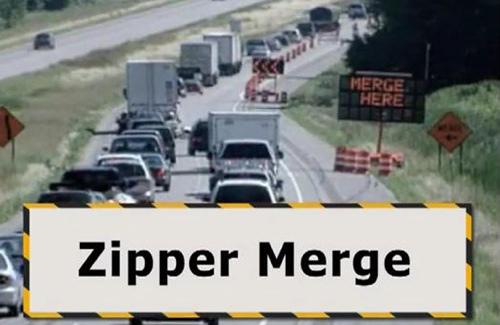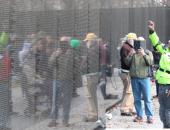
Most motorists start to merge as soon as they see warning signs and learn which lane ahead is closed. When the highway is not heavily congested and traffic is able to move at the speed limit, it is best to merge early into the open lane. However, in dense, slow moving traffic, the open lane fills quickly. When a driver in the closed lane can't move into the open lane in time, the closed lane ends forcing the vehicle to suddenly stop. The vehicle must now join traffic from a dead stop. This driving behavior can lead to lane switching, inconsistent driving speeds that cause crashes, long back-ups and road rage.
Research shows these dangers decrease and traffic moves more smoothly when motorists use both lanes until reaching the defined merge area and then alternate merging every other vehicle in "zipper" fashion into the open lane.
By using two full lanes of traffic until the merge, the speed difference is reduced between the two lanes. The length of backups is reduced 40-50 percent. When both lanes continue to move slowly, everyone is equally delayed, which reduces road rage.
Driving Tips for Merging:
With light congestion and traffic moving at the speed, merge out of the closed lane as early as possible.
With heavy congestion and slowed or stopped traffic, use both lanes and merge at the lane closure.
Drivers fill both lanes and take turns merging every other car at the point of the lane closure.

Bell City, Missouri - McKayla Hunt of Bell City was among the 98 high school students from across Missouri who participated in the Electric Cooperative CYCLE program, which stands for Cooperative Youth Conference and Leadership Experience.
The conference was held July 15-17, 2015, in Jefferson City. Hunt was sponsored by SEMO Electric Cooperative in Sikeston.
High school students learn first-hand what it is like to be involved in politics, the cooperative form of business and being a leader. The program included nationally known speakers and a day at the Missouri State Capitol learning how a bill goes through the process to become a law.
The CYCLE program is in its 12th year and is a recipient of the National Community Youth Service award for the top youth program among all electric cooperatives in the country.

Dexter, Missouri - Representatives from Countywide Insurance Agency delivered a Dividend Refund Check from Missouri Employers Mutual to the city of Dexter on Tuesday.
Missouri Employers Mutual is a worker’s compensation carrier for Countywide Insurance. They are recognizing Dexter for their 2012 safety record. The City of Dexter received this partial return of their insurance premium because they had a very low loss ratio for 2012. Insurance premiums are partially based on a policy holder's claims history over a 3-year period.
Zach Hedrick and Sharon McCord of Countywide Insurance presented a check in the amount of $4,076.41 to Crystal Bishop, City Clerk and Mark Stidham, City Administrator.
Shown in the photo are Sharon McCord, Zach Hedrick, Crystal Bishop, and Mark Stidham.
"County Wide Insurance Agency is located in Dexter Missouri. They provide personal insurance packages for car insurance, homeowners insurance and more. Businesses throughout Arkansas and Missouri also rely on them for complete commercial insurance needs, whether you need a Business Owners Policy , agricultural insurance , commercial auto insurance or a customized package incorporating many difference coverage options.
As an independent insurance agency, they will shop around with several carriers to get you the most affordable rates. Not sure what you need? That is what they are here for. They will assess your risks and offer you a variety of products to choose from. Service, whether it is in response to an insurance claim or general question, is the most important value they offer you."
If you are interested in purchasing insurance or would like a quote please contact them at 573-624-5540 or visit their website County Wide Insurance. You can also follow them on Twitter and Facebook. County Wide Insurance is located at 140 S. Walnut in Dexter.
The statement, titled "HONORING THE VICTIMS OF THE TRAGEDY IN CHATTANOOGA, TENNESSEE" was dated July 21, 2015.
THE WHITE HOUSE
Office of the Press Secretary
For Immediate Release July 21, 2015
HONORING THE VICTIMS OF THE TRAGEDY IN CHATTANOOGA, TENNESSEE
BY THE PRESIDENT OF THE UNITED STATES OF AMERICA
A PROCLAMATION
Our thoughts and prayers as a Nation are with the service members killed last week in Chattanooga. We honor their
service. We offer our gratitude to the police officers and first responders who stopped the rampage and saved lives.
We draw strength from yet another American community that has cometogether with an unmistakable message to those who would try and
do us harm: we do not give in to fear. You cannot divide us. And you will not change our way of life.
We ask God to watch over the fallen, the families, andtheir communities. As a mark of respect for the victims of the
senseless acts of violence perpetrated on July 16, 2015, in Chattanooga, Tennessee, by the authority vested in me as
President of the United States by the Constitution and the laws of the United States of America, I hereby order that the flag
of the United States shall be flown at half-staff at the White House and upon all public buildings and grounds, at all
military posts and naval stations, and on all naval vessels of the Federal Government in the District of Columbia and
throughout the United States and its Territories and possessions until sunset, July 25, 2015. I also direct that the flag shall
be flown at half-staff for the same length of time at all United States embassies, legations, consular offices, and other
facilities abroad, including all military facilities and naval vessels and stations.
IN WITNESS WHEREOF, I have hereunto set my hand this twenty-first day of July, in the year of our Lord
two thousand fifteen, and of the Independence of the United States of America the two hundred and fortieth.
BARACK OBAMA

Applicants must possess a high school diploma or GED. Prior dispatch experience preferred, but not required. Due to the nature of the job, applicants should be able to multitask under high stress situations. Applicants must be able to pass a thorough background examination and drug screening.
Benefits include health insurance, dental and vision insurance (optional), life insurance and enrollment with Missouri Local Government Employees Retirement System (LAGERS), which is paid for by the City of Dexter. Vacation time, sick time, personal and safety days are also included in the benefits package.
If you are interested in this unique job opportunity, download and print the application AND release form located at:
http://dexterpd.com/employment.html
Once the application is completed, return the application in person or via mail to:
Dexter Police Department
305 Cooper Street
Dexter, Missouri 63841
E-mailed applications will not be accepted.








